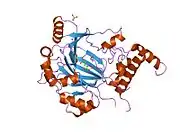HIF1A
فاکتور ۱-آلفا القاشونده توسط هیپوکسی (انگلیسی: Hypoxia-inducible factor 1-alpha) یک پروتئین است که در انسان توسط ژن «HIF1A» کُدگذاری میشود.[4][5][6]
عملکرد
این مولکول یک زیرواحد از فاکتور رونویسی القاشونده توسط هیپوکسی و یکی از عوامل مهم ساماندهی بیان ژن در پاسخ به هیپوکسی است. هرگونه تغییر در ژن سازندهٔ این پروتئین در بروز برخی انواع سرطان، و همچنین در تغییر در فرایندهایی نظیر رگزایی، سوختوساز، دوام سلول و تهاجم تومورها نقش دارد.[6][7]
اهمیت بالینی
افزایش بیان ژن HIF-1 در بسیاری از سرطانهای انسان مشاهده شدهاست[8][9] که از آن میان میتوان به سرطان روده بزرگ، سرطان پستان، سرطان لوزالمعده، سرطان کلیه، سرطان پروستات، سرطان تخمدان، تومور مغزی و سرطان مثانه اشاره کرد.[9][8]
افزایش سطح Hif-1a در سرطان دهانه رحم، سرطان ریه غیر سلول کوچک، سرطان پستان، اولیگودندروگلیومای مغز، سرطان دهان و گلو، سرطان تخمدان، سرطان مخاط رحم، سرطان مری، سرطانهای سر و گردن و سرطان معده مشاهده شده و با افزایش پیشرفت سریع بیماری مرتبط است به نحوی که میتوان از آن، جهت تعیین پیشآگهی بیماری و پیشبینی احتمال مقاومت به پرتودرمانی و شیمیدرمانی و افزایش احتمال مرگ استفاده نمود.[7][10][11][12][13][14][10]
منابع
- GRCm38: Ensembl release 89: ENSMUSG00000021109 - Ensembl, May 2017
- "Human PubMed Reference:". National Center for Biotechnology Information, U.S. National Library of Medicine.
- "Mouse PubMed Reference:". National Center for Biotechnology Information, U.S. National Library of Medicine.
- Semenza GL, Rue EA, Iyer NV, Pang MG, Kearns WG (June 1996). "Assignment of the hypoxia-inducible factor 1alpha gene to a region of conserved synteny on mouse chromosome 12 and human chromosome 14q". Genomics. 34 (3): 437–9. doi:10.1006/geno.1996.0311. PMID 8786149.
- Hogenesch JB, Chan WK, Jackiw VH, Brown RC, Gu YZ, Pray-Grant M, Perdew GH, Bradfield CA (March 1997). "Characterization of a subset of the basic-helix-loop-helix-PAS superfamily that interacts with components of the dioxin signaling pathway". The Journal of Biological Chemistry. 272 (13): 8581–93. doi:10.1074/jbc.272.13.8581. PMID 9079689.
- "Entrez Gene: HIF1A hypoxia-inducible factor 1, alpha subunit (basic helix-loop-helix transcription factor)".
- Semenza GL (October 2003). "Targeting HIF-1 for cancer therapy". Nature Reviews. Cancer. 3 (10): 721–32. doi:10.1038/nrc1187. PMID 13130303.
- Zhong H, De Marzo AM, Laughner E, Lim M, Hilton DA, Zagzag D, Buechler P, Isaacs WB, Semenza GL, Simons JW (November 1999). "Overexpression of hypoxia-inducible factor 1alpha in common human cancers and their metastases". Cancer Research. 59 (22): 5830–5. PMID 10582706.
- Talks KL, Turley H, Gatter KC, Maxwell PH, Pugh CW, Ratcliffe PJ, Harris AL (August 2000). "The expression and distribution of the hypoxia-inducible factors HIF-1alpha and HIF-2alpha in normal human tissues, cancers, and tumor-associated macrophages". The American Journal of Pathology. 157 (2): 411–21. doi:10.1016/s0002-9440(10)64554-3. PMC 1850121. PMID 10934146.
- Aebersold DM, Burri P, Beer KT, Laissue J, Djonov V, Greiner RH, Semenza GL (April 2001). "Expression of hypoxia-inducible factor-1alpha: a novel predictive and prognostic parameter in the radiotherapy of oropharyngeal cancer". Cancer Research. 61 (7): 2911–6. PMID 11306467.
- Höckel M, Vaupel P (February 2001). "Tumor hypoxia: definitions and current clinical, biologic, and molecular aspects". Journal of the National Cancer Institute. 93 (4): 266–76. doi:10.1093/jnci/93.4.266. PMID 11181773.
- Dvorák K (May 1990). "[Intravenous systemic thrombolysis using streptokinase in the treatment of developing cardiogenic shock in myocardial infarct]". Vnitrni Lekarstvi (به Czech). 36 (5): 426–34. PMID 2375073.
- Birner P, Schindl M, Obermair A, Breitenecker G, Oberhuber G (June 2001). "Expression of hypoxia-inducible factor 1alpha in epithelial ovarian tumors: its impact on prognosis and on response to chemotherapy". Clinical Cancer Research. 7 (6): 1661–8. PMID 11410504.
- Bos R, van der Groep P, Greijer AE, Shvarts A, Meijer S, Pinedo HM, Semenza GL, van Diest PJ, van der Wall E (March 2003). "Levels of hypoxia-inducible factor-1alpha independently predict prognosis in patients with lymph node negative breast carcinoma". Cancer. 97 (6): 1573–81. doi:10.1002/cncr.11246. PMID 12627523.
- مشارکتکنندگان ویکیپدیا. «HIF1A». در دانشنامهٔ ویکیپدیای انگلیسی، بازبینیشده در ۱۶ مارس ۲۰۲۰.
برای مطالعهٔ بیشتر
- Semenza GL (August 2000). "HIF-1 and human disease: one highly involved factor". Genes & Development. 14 (16): 1983–91. PMID 10950862.
- Semenza G (September 2002). "Signal transduction to hypoxia-inducible factor 1". Biochemical Pharmacology. 64 (5–6): 993–8. doi:10.1016/S0006-2952(02)01168-1. PMID 12213597.
- Arbeit JM (2002). "Quiescent hypervascularity mediated by gain of HIF-1 alpha function". Cold Spring Harbor Symposia on Quantitative Biology. 67: 133–42. doi:10.1101/sqb.2002.67.133. PMID 12858534.
- Sitkovsky M, Lukashev D (September 2005). "Regulation of immune cells by local-tissue oxygen tension: HIF1 alpha and adenosine receptors". Nature Reviews. Immunology. 5 (9): 712–21. doi:10.1038/nri1685. PMID 16110315.
- Mobasheri A, Richardson S, Mobasheri R, Shakibaei M, Hoyland JA (October 2005). "Hypoxia inducible factor-1 and facilitative glucose transporters GLUT1 and GLUT3: putative molecular components of the oxygen and glucose sensing apparatus in articular chondrocytes". Histology and Histopathology. 20 (4): 1327–38. doi:10.14670/HH-20.1327. PMID 16136514.
- Schipani E (2006). "Hypoxia and HIF-1 alpha in chondrogenesis". Seminars in Cell & Developmental Biology. 16 (4–5): 539–46. doi:10.1016/j.semcdb.2005.03.003. PMID 16144691.
- Haase VH (August 2006). "Hypoxia-inducible factors in the kidney". American Journal of Physiology. Renal Physiology. 291 (2): F271–81. doi:10.1152/ajprenal.00071.2006. PMC 4232221. PMID 16554418.
- Liang D, Kong X, Sang N (November 2006). "Effects of histone deacetylase inhibitors on HIF-1". Cell Cycle. 5 (21): 2430–5. doi:10.4161/cc.5.21.3409. PMC 4505804. PMID 17102633.










